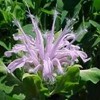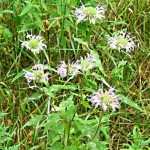Bergamot Herb – Monarda fistulosa
|
Current Demand = Normal |
Parts Used: Herb |
    |
Family: Lamiaceae
Common names : Beebalm and Oswego Tea
Description:Monadra Fistulosa or Bergamot has a pleasant scent and grow up to 5 feet with rose-purple to lavender flowers. They have high and branched, hairy stems and spreads by seeds and rhizomes. The leaves are toothed, aromatic, oblong, grayish-green and are often used in teas. Wild Bergamont has square stems and gray-green foliage. The wildflowers bloom from late May to August. They are solitary and terminal on the flowering branches and the two stamens surpass the upper lip.
Growing regions: Bergamot can be found from Ontario along the east coast south to Georgia, west to Missouri and north to Minnesota. It can often be found along roadsides, in pastures and open woods near logging trails as well as barnyards.
Harvesting/Drying
Parts Used: herb
The leaves and flowers For maximum potency, Bergamot should be harvested during the mature flowering stage of June to September. All aerial parts (above the ground) can be harvested. Cut plant just above the surface of the ground leaving the root system for future growth.Make sure all roots and foreign objects (stones, grass or tree leaves) are removed. In a warm place such as a barn loft or attic, either place plants in a thin layer on a screen if possible, or hang multiple plants together in small bunches. When drying any leaf or herb avoid sunlight as this will bleach the color of your herbs and greatly decrease their value. If you prefer to hang your herbs for drying, do not tie the bunches to tight or the stems will mold. If drying on a flat surface turning daily is recommended to speed the drying process and discourage mold. Avoid combining fresh crops with dry or partially dry crops. When handling dried herbs take care to avoid crushing too many leaves and stems. Keeping dried plants in tact will often increase the value of your crop.The key to drying herbs, roots or bark is an even combination of heat and airflow.Once your herbs are completely dry (largest stem will snap not bend and leaves will crumble) pace the herb carefully into a cardboard box or paper bag for storage in a dry area until you are ready to sell or use. Do not store herbs in plastic or it will mold.
Planting/Propagation Bergamot is a perennial that grows best in moist, light soil and areas that are exposed to sunlight. It does tolerate shade as long as the soil remains damp. It is an ornamental plant and readily propagated by its creeping roots and by slips of cuttings. It can vary in color from white through pink to dark red and purple. The roots systems can be divided about every three years and there will still be plenty of roots to share with others.Sow seeds in flats during January and store in a greenhouse and they will germinate in one to two weeks. The soil mix can be one-third sand and two-thirds commercial plug mix. Apply a starter fertilizer solution for the seedlings. Water the flats when dry to touch. Keep seedlings in flats no longer than 8 weeks and transplant into 3” pots. Continue to water as the surface dries. Pinch off the tops of the plants several times during the growing process and encouraging the branching and bushier habit. Apply a fertilizer once a week. When the roots have filled the pots they are ready for garden planting. The seedlings should be planted in a sunny, weed-free well-drained soil, one and one-half to two feet apart. Water, until rains come. Propagation by cuttings: Take stem tip cuttings, 3-4 inches long, any time from May to August. Remove the lower leaves and all flower or seed heads and insert the stems into a sand and per lite-rooting medium. Bury each cutting up to the first node. Place the cuttings in an enclosed area and mist them several times a day. In 4 to 5 weeks the cuttings should be well rooted and can be transplanted to pots. Then place from the pots to the garden in the early autumn. During the dry summers continue to supply water to help establish the wild bergamot. Continue mowing the area, once a year, after the hardest killing frosts or the following spring. This keeps woody plants from encroaching and removes plants that have died back. Since the plant spreads by rhizomes, it can get aggressive. The plant can be kept from spreading by divisions. Division of large plants every 2 to 3 years also keeps them healthy. Mature clumps can be divided in March before they send up stems. Dig up a portion of the clump and divide it into sections. Replant and water the divisions promptly. Continue to add leaf mold and compost to your soil, as the plant’s shallow root systems spread easily through light soil.
Attribute
“Purple Flower Wild Bergamot DSC 0172” by Daniel Gross – Own work. Licensed under CC BY-SA 4.0 via Wikimedia Commons.
“Wild Bergamot, Ottawa” by D. Gordon E. Robertson – Own work. Licensed under CC BY-SA 3.0 via Wikimedia Commons.
 Root Buyer
Root Buyer